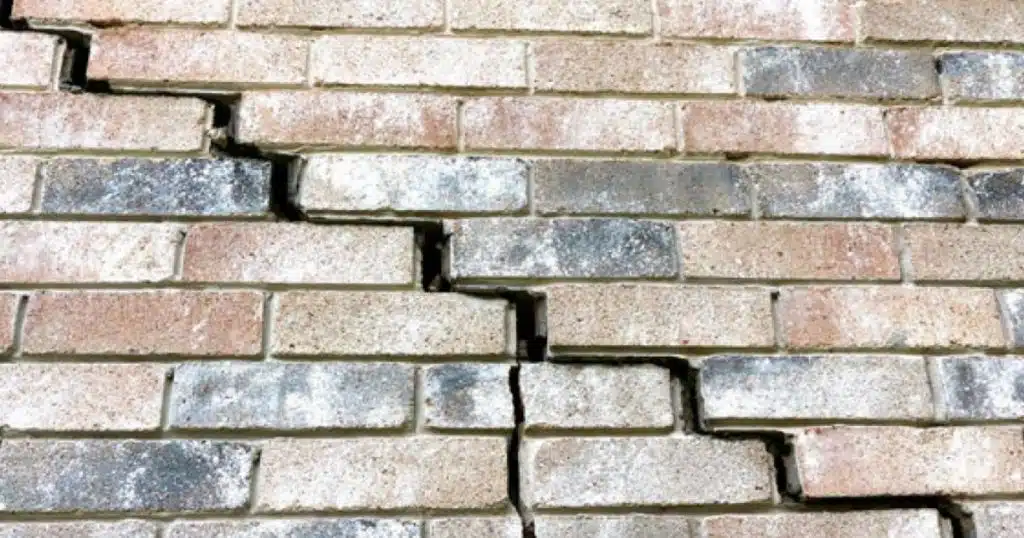
Foundation cracks are a common problem that can manifest in various ways, compromising structural integrity and the home’s safety. When you spot a crack, questions arise about whether they are harmless or a signal for structural problems, underscoring the urgency of early detection and repair.
This comprehensive guide will discuss 8 different types of foundation cracks, their appearance, causes, signs of damage, and how to identify the type before repairing foundation cracks to avoid escalating into major problems in your home.
1. Horizontal Foundation Cracks
Appearance: A horizontal crack runs parallel to the ground across the walls.
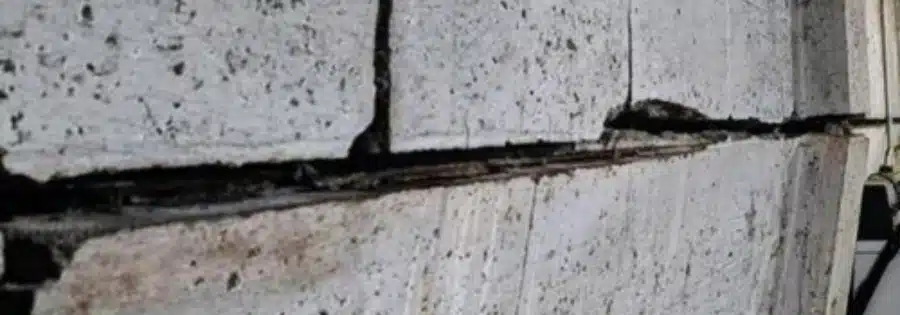
Horizontal cracks in your basement foundation walls can cause serious concern and indicate significant structural issues. These occur horizontally when the soil becomes excessively saturated with water, putting hydrostatic pressure on the foundation wall.
If left unaddressed, these structural foundation cracks can lead to a bowing wall and water leakages into basement, compromising your home’s structural stability.
Causes of Horizontal Cracks
- Excessive moisture from heavy rainfall or flooding which can cause hydrostatic pressure.
- Inadequate drainage system, which includes improper grading, poorly functioning gutters, or insufficient downspout extension.
- Constant freezing and thawing cycle.
Repair Options
Neglecting to repair a horizontal foundation crack can severely damage your home. Seek expert help as professionals can effectively address these issues through repair options like installing interior or exterior drainage systems, reinforcing the wall with epoxy injection, carbon fiber straps, or steel I-beams, and installing wall anchors or push piers for stabilization.
2. Vertical Foundation Cracks
Appearance: Vertical gaps run top to bottom on walls and are often narrower at the top and wider at the base.
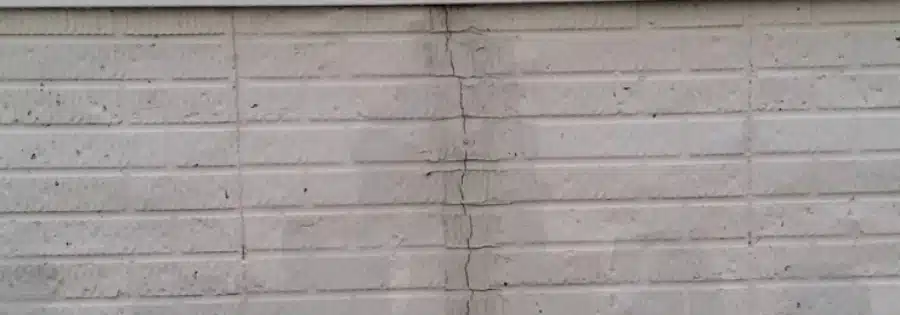
A vertical foundation crack can point to an underlying problem depending on its width and length and how suddenly it appears. They are often caused by foundation settlement. These are more common in new constructions and are often caused by settling and the natural concrete curing process.
They often manifest in the middle of walls and tend to measure around 1/8 inch in width. If these gaps surpass the 1/8 inch mark, it signifies a more severe issue, warranting professional assistance for resolution.
Causes of Vertical Cracks
- Natural settling process of a house or building.
- Shrinkage of concrete.
Repair Options
It’s crucial to promptly address these home foundation cracks, as they can worsen and widen over time, potentially allowing water to enter your basement.
Regularly inspect and seal small vertical gaps and watch for significant changes or widening. If you notice them worsening, don’t hesitate to contact foundation experts for an assessment.
More minor gaps can be sealed using epoxy or polyurethane injection to prevent water intrusion.
3. Hairline Foundation Cracks
Appearance: thin, superficial gaps that are often less than 1/16-inch wide.
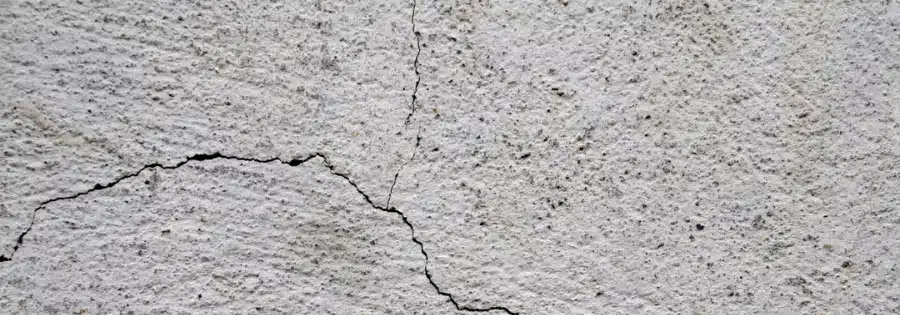
Hairline foundation cracks are the most common and are typically non-structural. They are barely noticeable and usually develop days or weeks after construction, as concrete or mortar dries during the curing process.
Hairline cracks in concrete are generally not a cause for concern if they meet specific criteria: remain a width of approximately 1/8 inch, no vertical displacement, no water penetration, and no increase in size over time.
When meeting these criteria, they are considered normal foundation cracks and do not require immediate attention or repairs. However, it’s still a good practice to monitor them periodically for any changes to ensure they remain non-threatening.
Causes of Hairline Cracks
- Improper procedures during the construction process.
- Temperature changes.
- Normal settling or shrinkage of the concrete.
Repair Options
Smaller hairline cracks can be sealed using a waterproofing sealant to prevent moisture intrusion, while more significant or more extensive damages may require epoxy or polyurethane injections.
4. Stair Step Foundation Cracks
Appearance: These gaps run along the mortar joints in a “stair-step” pattern, following the path of least resistance between the bricks or concrete blocks.
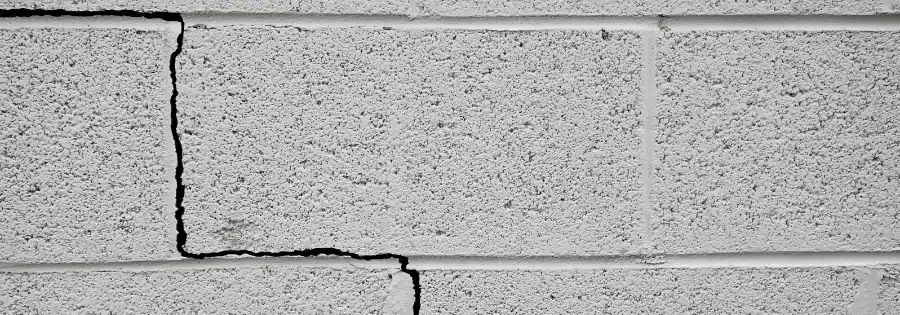
Stair-step cracks form a zigzag pattern, commonly observed in retaining walls or block foundations, typically caused by excessive soil pressure or uneven settlement.
When this occurs, the mortar joints of the blocks tend to crack. These follow a stair-step pattern throughout the concrete wall and indicate an underlying structural issue that requires attention.
Causes of Stair Step Cracks
- Moisture issues.
- Differential foundation settlement, when one part of the foundation settles at a different rate than another.
- Shifting of the foundation.
Repair Options
Repointing the affected mortar joints and sealing the gaps with a waterproofing compound can help prevent moisture intrusion. In cases of severe differential settlement, underpinning push piers or helical pier installation may be necessary for stabilization.
5. Diagonal Foundation Cracks
Appearance: This usually appears at a 30-75-degree angle from vertical and can extend from one corner of a wall to another.
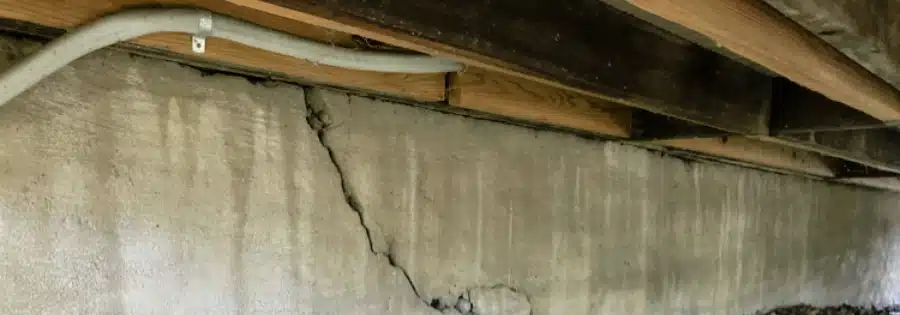
Depending on the size, diagonal foundation cracks can be a cause for concern if they are widening and structural issues are present. They can be noticed vertically about 30 degrees in alignment with the basement wall. Diagonal cracks are typically seen in concrete block foundation walls.
However, when a diagonal crack shows a noticeable difference in width between its ends, it may signal more significant structural problems like ongoing foundation movement or instability.
In such instances, it’s essential to seek a professional home inspection to evaluate the severity of the crack and any potential risks it may pose.
Causes of Diagonal Cracks
- Natural curing of the concrete foundation wall.
- Differential settling of the foundation
- Seismic activity
- Expansive soil
- Damage from a shrub/tree close to the concrete wall
Repair Options
Depending on their severity, these can be repaired with epoxy injection or carbon fiber reinforcement, or if the settlement is severe, piers can be installed to lift the settled part.
6. Shrinkage Foundation Cracks
Appearance: Thin, randomly distributed hairline gaps that resemble a network of interconnected lines, usually less than 1/8-inch wide.
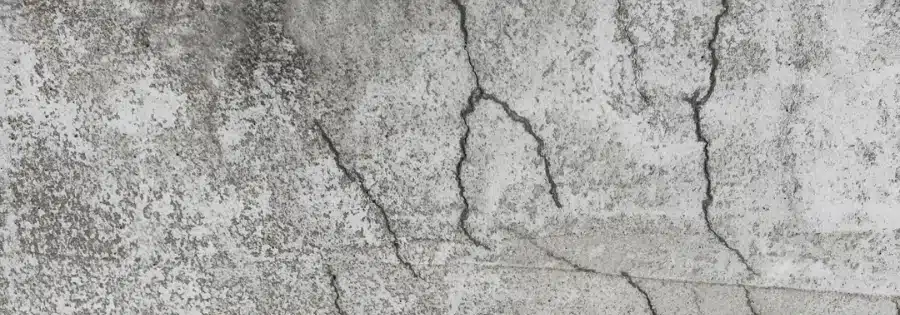
Shrinkage cracks are typically not a major concern. They are small and fine and are usually even in size and shallow. These occur in poured concrete foundations form during the initial curing phase within the first one to two months after it has been poured. They develop as the concrete shrinks when it gradually dries out and loses moisture.
They typically do not pose a threat to your home’s structural integrity. However, suppose your location has high levels of Radon Gas, an odorless and colorless radioactive gas naturally emitted from rocks, soil, and water. In that case, it can infiltrate and affect indoor air quality through these gaps.
Prolonged exposure to radon levels can increase the risk of lung cancer when the gas is inhaled, which can be a significant risk to your family’s health.
Causes of Shrinkage Cracks
- Rapid concrete drying and a lack of proper control joints or curing during construction.
- Rapid dehydration and evaporation of water from concrete during curing.
Repair Options
Generally, they are considered normal and are not a cause for concern. However, it is essential to monitor them and ensure that they do not widen or spread. A professional can assess whether these need to be repaired. When detected early, the repair is relatively simple; sealant application or epoxy injections can keep moisture and water seepage.
7. Foundation Slab Cracks
Appearance: Long, usually horizontal gaps that may run the length of the slab.
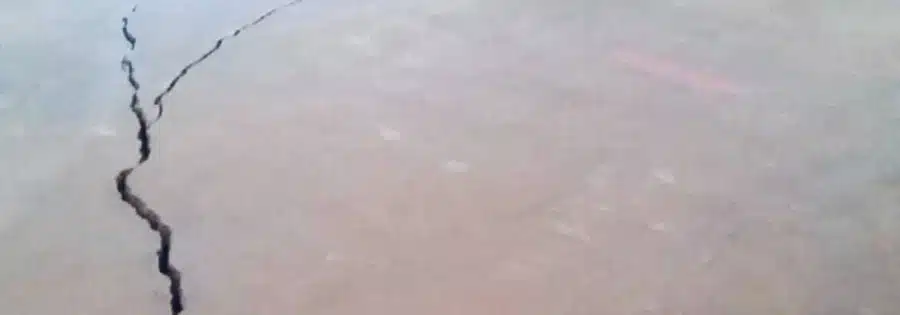
Poured concrete slabs are susceptible to developing cracks over time. Foundation slab cracks are often more visible than shrinkage cracks.
These types of concrete cracks can be horizontal, vertical, diagonal, or stair-stepped in appearance and have the potential to create an uneven or sloping floor surface.
Causes of Foundation Slab Cracks
- Concrete slab’s natural drying, settling, and curing.
- Slab settlement that might occur due to poor workmanship or inadequate soil compaction.
- Crawl space slabs at or above grade are susceptible to frost heave. The water beneath the slab can freeze in freezing conditions, leading to concrete buckling.
- Changes in weather conditions.
Repair Options
Repair options depend on the severity of the issue. Minor concrete cracks may be addressed with patching, epoxy injections, or sealant application.
Significant gaps may require repair, which involves injecting high-density Polyurethane foam beneath to lift and level the slab. Or a Slab replacement, which is removing the damaged slab and pouring a new one, or pier installation to stabilize the structure and prevent further damage to the property.
8. Wet Foundation Cracks
Appearance: Narrow, damp gaps usually look similar to shrinkage but are accompanied by water infiltration.
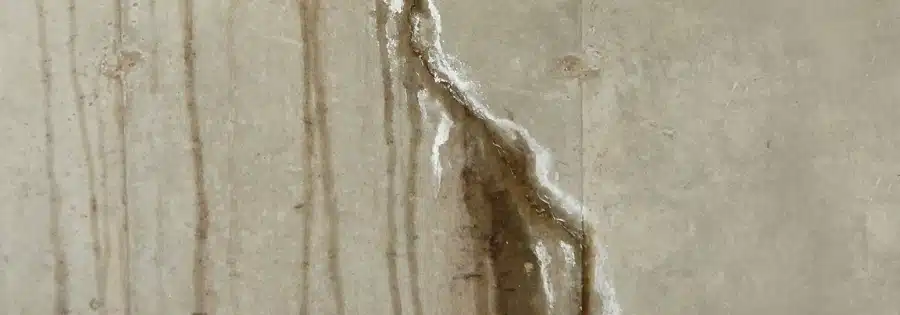
Wet foundation cracks often appear wider than dry cracks and may show signs of dampness or water infiltration. These result from the foundation shrinking as the concrete loses moisture through evaporation.
Typically, this occurs within the first month after the foundation has been poured. If the concrete mix initially contains more moisture, it’s more prone to significant shrinkage, which raises the chances of gaps developing.
These gaps might let in water, especially during heavy rains. While they don’t typically threaten the structure of the building, they can cause secondary issues such as mold growth, wood rot, other water-related damage, and other related problems.
Causes of Wet Foundation Cracks
- Water infiltration
- Poor drainage systems
- Improper waterproofing
Repair Options
Repair options include waterproof sealant application by injecting them with polyurethane foam or epoxy, interior or exterior basement waterproofing, and drainage system improvements around the house to prevent future water infiltration.
Fix the Above Types of Foundation Cracks Now to Protect Your Home!
Not all foundation cracks should cause you to lose sleep; however, understanding them is the initial step in home maintenance and securing the future of your home. Don’t delay until it becomes a serious issue. Take proactive measures to inspect, diagnose, and address any gaps you may discover.
At Lux Foundation Solutions, we specialize in providing homeowners with effective foundation repair services in resolving various types of foundation cracks in Northern Virginia, WV, and surrounding areas. We offer comprehensive assessments of your home’s condition and offer the best possible solutions tailored to your needs. Contact us at (540) 508-8587 for more information and to get a free estimate today. Your home’s stability and your family’s safety are our top priorities. Act now to secure your peace of mind for years to come!
Commonly Asked Questions
How to fix foundation cracks?
Fixing foundation cracks is a crucial step in maintaining the structural integrity of your home. The method you choose will depend on the type and severity.
Here are the general steps for repairing:
1. Identify the type of crack.
2. Gather the necessary tools and materials.
3. Prepare
4. Seal small non-structural gaps
5. Inject epoxy or polyurethane for thin gaps
6. Patch larger gaps with hydraulic cement.
7. Reinforce structural gaps
8. Monitor and prevent future gaps.
9. Seek professional help if needed.
Are foundation cracks normal?
Some foundation cracks are normal and insignificant, such as small gaps that often occur due to the settling of a house over time.
However, not all are normal; horizontal, vertical, or jagged diagonals, widening gaps, or accompanied by other signs like bowing walls or water intrusion are not normal. They may indicate serious structural issues that a professional should inspect and repair.
While some degree of cracking can be common, it’s essential to differentiate between minor cosmetic and more significant structural issues.
If you’re concerned about these issues in your home, it’s advisable to consult with a professional to assess the situation and recommend appropriate repairs if necessary.
When to worry about foundation cracks?
While not all are cause for immediate alarm, there are specific signs and circumstances that you should take seriously when foundation cracks to be concerned about:
1. Wider than a quarter-inch (approximately 6mm), especially in a horizontal or stair-step pattern, can indicate structural issues.
2. If one side of a crack is higher or lower than the other, it may signal settlement, which can lead to serious problems.
3. The presence of multiple cracks in one area or on different house walls could point to a broader structural problem, necessitating prompt attention.
4. Near doors and windows, especially if they affect alignment or ease of use, might indicate structural movement.
5. They are seen in interior walls, ceilings, and around door frames, and sloping or uneven floors can suggest structural issues.
6. Gaps that allow moisture or water infiltration into your basement or crawl space need immediate attention to prevent mold growth and water damage.
7. If they widen or lengthen, it’s a sign of worsening issues requiring professional evaluation.
8. Consider your location and environmental conditions. Homes in areas prone to soil movement, high water tables, or seismic activity may be more susceptible to structural problems.
9. If doors and windows suddenly stick or jam when they used to operate smoothly, it may be due to structural shifts.
10. When uncertain, consult a professional foundation specialist. They can assess, identify the cause, and provide guidance on
When are foundation cracks a problem?
Foundation cracks become problematic when they exhibit certain characteristics or conditions that suggest potential structural issues or water infiltration. These include
1. gaps wider than 1/8 inch and longer than a few feet,
2. gaps near the foundation base,
3. active movement in the gaps,
4. water seepage,
5. horizontal, vertical, stair-step, or diagonal cracks; and
6. difficulty in opening or closing doors and windows.
These signs should prompt homeowners to take action, as they may indicate serious problems that require attention to ensure the home’s safety and stability.
What type of foundation cracks are bad?
Horizontal or jagged diagonal cracks are particularly concerning for homeowners.
Horizontal cracks often indicate serious structural issues because they suggest the foundation is under significant pressure or stress. Jagged diagonals can also be problematic, as they may tell settlement or movement.
Both types of these can lead to water infiltration, further compromising the home’s integrity and potentially causing damage to the home. It’s essential to address these issues promptly to prevent worsening structural problems and costly repairs.
What causes foundation cracks?
Foundations can develop cracks due to various factors, including
1. soil settlement,
2. expansive soil,
3. hydrostatic pressure from water buildup,
4. freeze-thaw cycles,
5. poor construction or design,
6. tree roots,
7. earthquakes,
8. erosion,
9. plumbing leaks,
10. and poor drainage.
These factors can individually or collectively contribute to structural issues. Addressing the underlying cause is crucial to prevent further damage. Regular inspections, proper maintenance, and timely repairs can help mitigate the risk of problems and prolong the home’s lifespan.
If you notice these issues or have concerns, consulting a professional foundation crack repair specialist is advisable for a thorough assessment and appropriate action.
How do I keep my house foundation from cracking?
Maintaining your house to prevent foundation cracks and preserving structural integrity is essential for newly constructed and already-built homes.
For new homes during construction, ensure proper site preparation, consult a structural engineer for foundation design, use quality materials and techniques, plan for adequate drainage, grade the landscape away from the basement, install vents in crawl spaces, control tree roots, and adhere to local building codes.
For already built homes, maintain proper drainage, conduct regular home foundation inspections, promptly seal cracks, keep drainage systems clear of debris, maintain consistent moisture levels, avoid overwatering near the foundation, trim encroaching tree roots, schedule professional inspections, and be cautious with heavy loads. These measures protect your home’s stability, whether a new build or an existing home.
